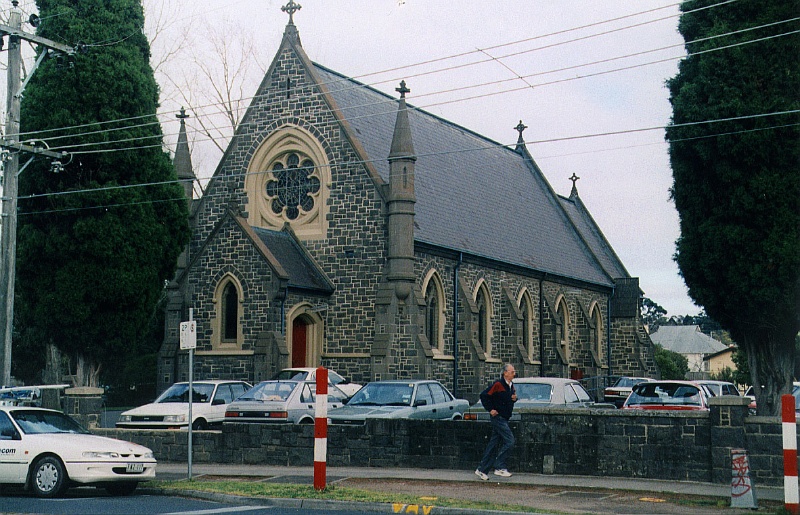ST JOHN'S ROMAN CATHOLIC CHURCH AND PRESBYTERY
52 Yarra Street HEIDELBERG, Banyule City
-
Add to tour
You must log in to do that.
-
Share
-
Shortlist place
You must log in to do that.
- Download report


Statement of Significance
St John's Church, Heidelberg is of local architectural and historical significance. The church was designed by prominent 19th century Public Works and ecclesiastical architect William Wardell, whose notable church works in the Gothic Revival style include St Patrick's Cathedral, Melbourne and St Mary's Cathedral, Sydney. St John's Church is characteristic of the simplified English Decorated style employed by Wardell for his small church designs, being a simple rectangular volume with entrance porch and sacristy attached and of bluestone construction. The building, prominently sited on the corner of Cape and Yarra Streets, is a local landmark.
The adjacent presbytery, although altered and of little individual architectural significance, has historic links to the church, and together the church and presbytery form an architecturally related pair of buildings.The church continues to provide a focus of religious activity for the Catholic community in Heidelberg since its construction in 1861.
-
-
ST JOHN'S ROMAN CATHOLIC CHURCH AND PRESBYTERY - Physical Description 2
Property Description - Grant 2/1/1851, Crown Allotment 1-4/14, Warringal Village
ST JOHN'S ROMAN CATHOLIC CHURCH AND PRESBYTERY - Usage/Former Usage
Original Use: Church
Current Use: UnknownST JOHN'S ROMAN CATHOLIC CHURCH AND PRESBYTERY - Physical Description 1
Building
St John's church is in Wardell's simplified English Decorated Gothic Revival style. As with other Wardell parish churches in Melbourne such as St Mary's, East St Kilda, and St Ignatius, Richmond, the building is of quarry faced bluestone construction with sandstone dressings to window and doors surrounds, and a steeply pitched slated roof. The bluestone is random coursed. The building has a simple gabled volume with a projecting gabled entrance porch on the west front and a sacristy to the north east. The west gable features a large stained glass rose window. The gable apices are marked with crucifixes, and pinnacles mark the corners of the building. Pointed arched windows with stone tracery are set between stepped buttresses on the side elevations.The adjacent presbytery is a two-storey rendered building with steeply pitched slated roofs. The projecting gabled entrance porch is flanked by two gabled sections of different sizes, the larger gable having a two-storey, semi-octagonal bay window with single-paned, double-hung sash windows. A string course divides the two storeys.
LandscapeThe church yard, south of the building consists of mature trees dotted on an area of lawn. The largest of these are two Golden Poplars (Populus x canadensis) and a Himalayan Cedar (Cedrus deodara). The church yard is bordered to the east and south by a row of Bhutan Cypress (Cupressus torulosa) which form a striking landscape feature, and are typical plantings for early churchyards and cemeteries.
Bounding the site is a bluestone wall with a small pedestrian gate on the Yarra Street (southern) boundary. The gates are wrought iron and painted black. The landscape is a visual landmark for the area, and represents a relatively intact, formal landscape around a notable local church.
ST JOHN'S ROMAN CATHOLIC CHURCH AND PRESBYTERY - Physical Conditions
Good
ST JOHN'S ROMAN CATHOLIC CHURCH AND PRESBYTERY - Intactness
Good
ST JOHN'S ROMAN CATHOLIC CHURCH AND PRESBYTERY - Historical Australian Themes
Just as numerous as the Anglicans, though economically less influential, was the local Roman Catholic population in the local area. In 1851, with guidance from a set of trustees headed up by the Bishop of Melbourne, Bishop Goold, a Roman Catholic school was established on the site next to that reserved for the church. The bluestone St John's Roman Catholic Church was begun in 1860 on the corner of Yarra and Cape Streets. It is one of the earliest substantial Roman Catholic churches to survive in the state.
Heritage Study and Grading
Banyule - Banyule Heritage Study
Author: Allum Lovell & Associates
Year: 1999
Grading: B
-
-
-
-
-
PHOLIOTA
 Victorian Heritage Register H0479
Victorian Heritage Register H0479 -
ST JOHNS ANGLICAN CHURCH
 Victorian Heritage Register H0197
Victorian Heritage Register H0197 -
FORMER HEAD TEACHER'S RESIDENCE
 Victorian Heritage Register H1617
Victorian Heritage Register H1617
-
'Altona' Homestead (Formerly 'Laverton' Homestead) and Logan Reserve
 Hobsons Bay City
Hobsons Bay City
-
-












